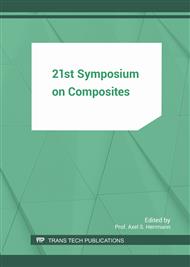p.238
p.246
p.255
p.263
p.271
p.278
p.287
p.294
p.302
High Performance Green Composites for Green Technologies
Abstract:
Composite materials do offer freedom to design a material fitting best to the requirements of a given application. In case of fiber reinforced polymers especially the low weight in combination with other favorable properties, e.g. high mechanical performance, are the driving force for their application. Materials from renewable resources are of high interest if sustainability is aimed. In this paper, in a holistic approach a green composite is aimed to be used in a rotor blade for wind energy production. The challenging topic for this approach is to identify a possibility to gain a thermoset resin being really green, i.e. based on renewable resources and being not critical, e.g. toxic, at any stage of the whole processing chain. For this purpose several different approaches are studied and compared with other solutions based on green resin systems from other resources and conventional petrochemical based resin systems. A hemp seed oil based epoxy resin has been tested successfully. But to be completely free of petrochemicals, bio-based hardener and catalysts are still an open topic. For manufacturing of a rotor blade an infusion process has been used and it was found, a through thickness impregnation of the natural fiber yarn based textile structure results in entrapped air. Only in-plane saturation delivered completely impregnated structures.
Info:
Periodical:
Pages:
271-277
Citation:
Online since:
July 2017
Keywords:
Price:
Сopyright:
© 2017 Trans Tech Publications Ltd. All Rights Reserved
Share:
Citation:


